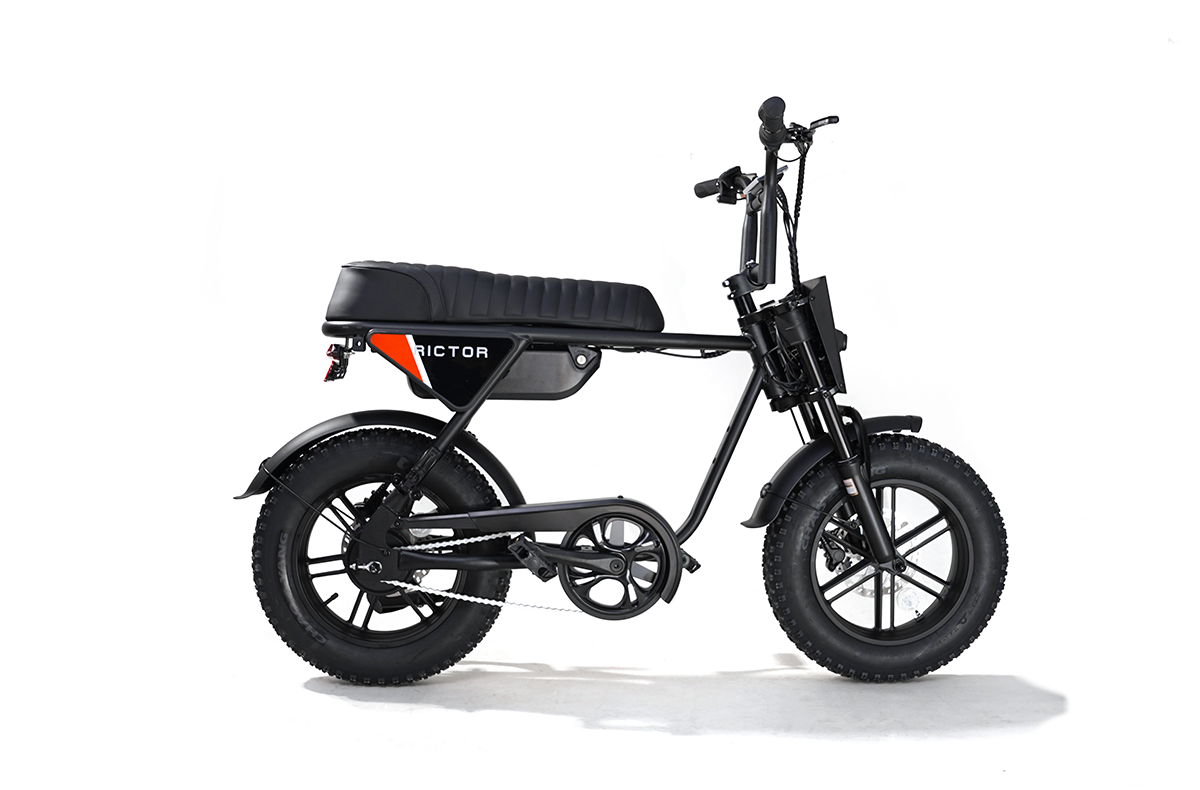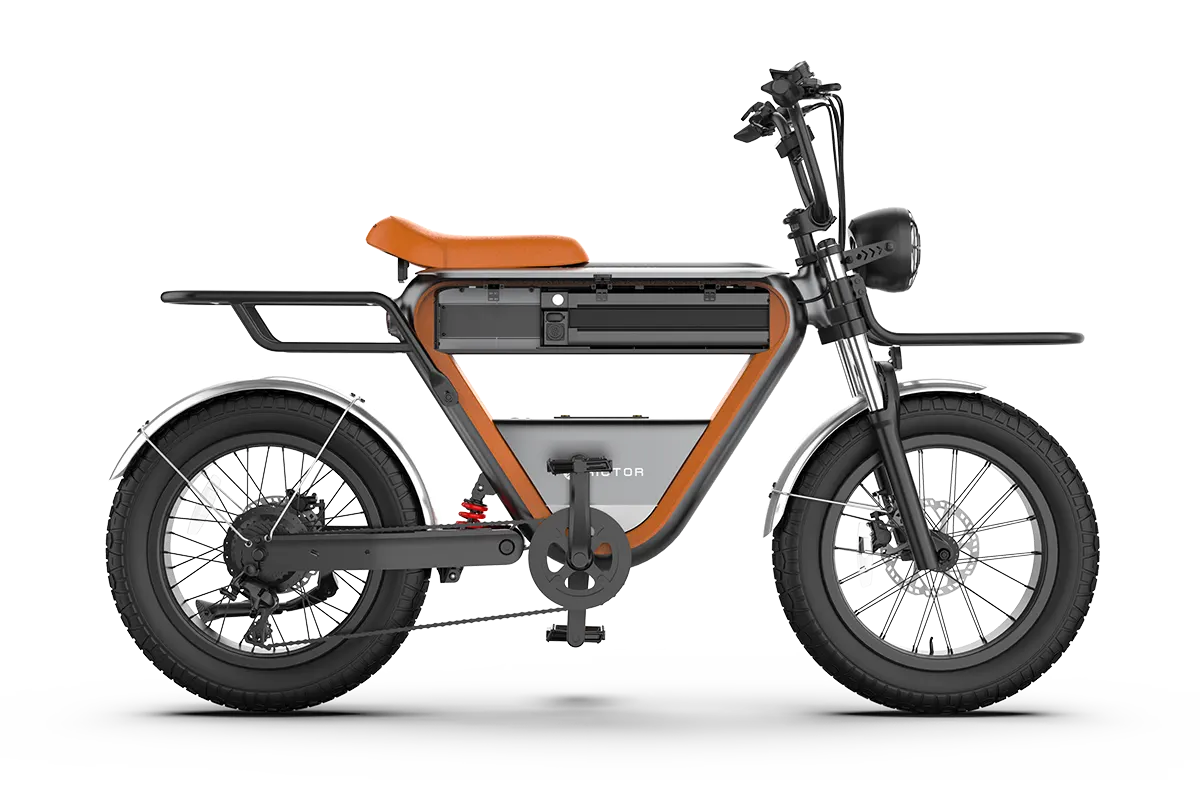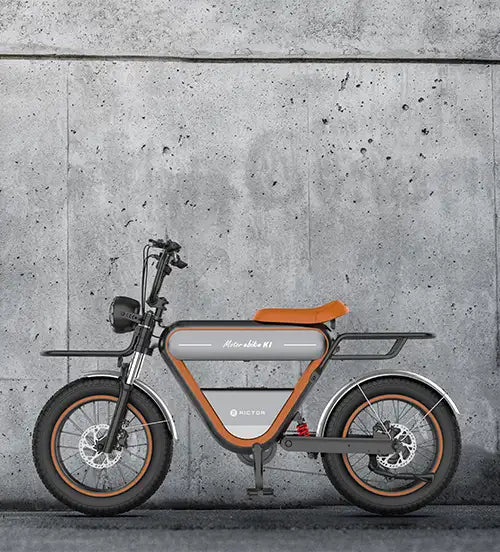
Tips For Bigger Guy To Choose Electric Bike
Are you a bigger guy struggling to find the right electric bike? You’ve probably Googled options and found yourself overwhelmed with choices. We get it – choosing the perfect electric bike isn’t always easy. Let's dive into how to pick the right electric bike for bigger riders!
Frame Size and Strength
The right frame size and strength are crucial, especially for bigger riders. The frame size should be proportionate to your height and weight to ensure comfort, control, and stability.
A properly sized frame allows you to ride comfortably without putting unnecessary strain on your body, while also maintaining the bike’s performance.
For larger riders, the frame should have a longer reach and a higher standover height.
Reach refers to the horizontal distance from the saddle to the handlebars, while standover height is the distance between the ground and the top tube when you stand over the bike. Generally, the larger the rider, the larger the frame should be.
-
For riders between 5’10” to 6’2”, a large (19-21 inches) frame size is typically recommended. The standover height should be around 30 to 32 inches.
-
For riders above 6’2”, an extra-large (21-23 inches) frame is often more suitable. The standover height could be around 32 to 34 inches.
Frame size is not solely determined by height; it must also accommodate your weight and inseam length.
A larger frame (21-23 inches) is generally better suited for heavier riders, typically those over 250 lbs. The larger frame offers better stability and control, especially for more demanding rides or hills.
For riders over 300 lbs, some electric bike brands offer reinforced frames or models specifically designed to support higher weight capacities. These bikes may feature a heavy duty frame with strengthened joints and materials that are reinforced to prevent bending or breakage under stress.
The most common materials for electric bike frames are aluminum and steel. The frame must be built to support the rider’s weight without compromising safety or performance.
Aluminum is lightweight, corrosion-resistant, and strong enough to support heavier riders.
Steel, although heavier than aluminum, offers superior durability and strength. Steel frames are ideal for riders who need extra support, especially those who plan to carry additional weight or ride on more rugged terrain.
Most standard electric bikes have a weight limit ranging from 250 lbs to 350 lbs, but some models are specifically designed for heavier riders and can support up to 400 lbs or more.
A well-built frame with reinforced joints will provide better support and reduce the risk of structural issues over time.
Weight Capacity
Each electric bike has a specified weight limit, which includes the rider, any accessories, and additional gear. Exceeding this limit can cause performance issues, safety risks, and premature wear and tear.
Rider weight + Additional gear weight = Total weight load.
If you are a rider weighing 280 lbs and plan to carry a 20 lbs backpack, the total weight the bike must support is:
280 lbs (rider) + 20 lbs (backpack) = 300 lbs total load.
In this case, a bike with a weight capacity of at least 350 lbs would be a good choice to ensure durability and safety. Bikes designed for heavier riders often have a higher weight capacity, typically 350 lbs or more, to support not just the rider’s weight but also any gear or additional loads.
If a bike has a 350 lbs capacity but you plan on carrying a lot of extra gear or even a child seat, it’s wise to choose a bike with a higher weight limit—around 400 lbs or more.
Many electric bike manufacturers design specific models for heavier riders with reinforced frames, stronger wheels, and heavy-duty components to handle the added load.
These bikes often come with heavy-duty tires and upgraded suspension systems to absorb impacts, making the ride smoother, especially on bumpy paths. Stronger tires also provide better grip, which is important for riders carrying more weight.
SEE ALSO What is a Fat Bike? Everything You Need to Know
Suspension System
Suspension system absorbs the shock from bumps, uneven roads, and rough terrain, ensuring a smoother ride. Without a proper suspension, the ride can become jarring, which may cause discomfort or even injury over time.
Front Suspension (Hardtail)
These bikes have suspension only in the front fork, which helps absorb shocks from the front wheels. While these bikes are generally lighter and less expensive, they may not provide the level of comfort needed for heavier riders or for those who ride on bumpy terrain regularly.
Full Suspension (Dual Suspension)
Bikes with dual suspension have both front and rear shocks, offering better overall comfort, stability, and control. This type of suspension is especially beneficial for heavier riders because it distributes the weight more evenly across the bike, reducing strain on the frame and providing better impact absorption.
For riders over 250 lbs, dual suspension is highly recommended.
-
Better shock absorption: With both front and rear suspension, the bike absorbs more of the road's impact, making the ride smoother and more comfortable.
-
Improved control: Dual suspension improves traction and handling, especially on rough terrain or when riding over obstacles. This means a more stable ride, reducing the likelihood of the bike bucking or losing grip.
-
Longer bike lifespan: A well-built suspension system protects the frame and other components by reducing the overall impact forces the bike experiences. This can help extend the bike’s lifespan, especially when carrying extra weight.
Some high quality suspension systems allow you to adjust the damping settings (how much the suspension compresses and rebounds) based on your weight, the type of terrain, or your personal riding preferences. Just like all terrain electric bike Rictor K1.
A quality suspension system is a must for heavier riders, offering better comfort, control, and durability. Opting for a dual suspension electric bike with adjustable and durable shocks will ensure a more comfortable and stable ride, even on rough or uneven surfaces.
Seat Comfort and Position
A poorly designed or uncomfortable seat can quickly turn a ride into a painful experience. Choosing the right seat can make all the difference, offering better support and reducing the strain on your body.
The seat needs to provide sufficient cushioning and support to handle the extra weight and provide comfort over long rides
-
Wide Seat: A wider seat can distribute weight more evenly, reducing pressure on sensitive areas, such as your lower back and pelvis. Many e-bikes designed for heavier riders feature wider, plush seats that provide better comfort for the saddle area.
-
Gel or Memory Foam Padding: Seats with gel or memory foam padding offer a soft, responsive feel that molds to your body. These materials absorb shock better, providing extra comfort, especially on rougher roads or longer rides.
-
Contoured Design: A contoured seat can help with posture by offering additional support where it’s needed most, like the lower back and hips. This can prevent aches or discomfort from prolonged riding.
Seat Position
Seat position affects both comfort and performance. A seat that is too high, too low, or incorrectly tilted can lead to discomfort, inefficiency, or even injury.
Seat Height: The height of the seat plays a major role in determining how comfortable your ride will be. A seat that is too low can cause your legs to remain bent for too long, leading to muscle fatigue and strain. On the other hand, a seat that is too high can make pedaling inefficient and uncomfortable. Ideally, when your pedal is at the lowest point, your knee should have a slight bend. Adjusting the seat height to achieve this optimal knee angle is important for comfort and efficiency.
If you have to reach up to the handlebars or feel like your knees are overly bent while pedaling, the seat is likely too low. Conversely, if your legs feel stretched out and you can’t pedal comfortably, the seat may be too high.
Seat Tilt: The angle at which your seat is positioned also plays a role in comfort. A slight tilt, where the front of the seat is tilted slightly downward, can reduce pressure on your lower back and help maintain a more natural riding posture. However, too much tilt can lead to discomfort and pressure on the hands and wrists, so it’s important to find a balanced, neutral angle.
Seat Fore-Aft Position: The horizontal position of the seat (how far forward or back it sits) can influence your body’s alignment while riding. A seat that is too far forward can cause unnecessary strain on your knees, while one that is too far back might affect your pedaling efficiency. Adjusting this position will help achieve a more balanced, comfortable ride.
Motor Power and Battery Range
A stronger motor ensures that the bike can handle the extra weight, while a long-lasting battery ensures you can ride comfortably for longer distances without worrying about running out of power.
Motor Power
For heavier riders, a more powerful motor is essential to maintain smooth acceleration, climb hills, and handle rough terrain. 500W motors may work for lighter riders but can struggle under heavier loads. For riders above 250 lbs, a 750W or 1000W motor is recommended. These motors provide enough power to tackle inclines, rough roads, and provide consistent speed, even with additional weight.
Battery Range
Battery capacity determines how far you can ride on a single charge. Larger riders should look for bikes with higher-capacity batteries (typically 48V or 52V systems) for better range. A bigger battery ensures that the bike can maintain consistent power throughout the ride, even with the added weight. Expect a range of 40-60 miles for riders with higher battery systems, depending on terrain and usage.
Tire Size
The right tires provide better traction, stability, and durability, which are all key factors when riding an electric bike. Larger riders need tires that can handle more weight without compromising performance.
There are two main types of tires to consider for bigger riders: standard tires and fat tires.
Standard Tires (26"-29"): These tires are suitable for riders with moderate weight and those who mostly ride on smooth or moderately rough roads. They are typically lighter and more aerodynamic, providing less rolling resistance. However, they may not offer the level of stability or shock absorption needed for heavier riders, especially on rough terrain or uneven surfaces.
Fat Tires (4"-5" wide): Fat tires are wider and offer more surface area, which distributes your weight more evenly across the ground. This results in better traction, stability, and shock absorption, especially on rough terrain or gravel paths. Fat tires are perfect for larger riders as they help reduce the strain on the bike frame and ensure a smoother ride, even on uneven surfaces like sand, snow, or muddy trails.
Tire Pressure
Over-inflated tires can lead to a rougher ride and less traction, while under-inflated tires may cause poor handling and risk of flats. For larger riders, it’s important to keep the tire pressure at a level that ensures both comfort and safety. Generally, the recommended tire pressure is marked on the tire sidewall, but a good rule of thumb is to keep fat tire pressure around 10-20 PSI for better shock absorption, and standard tire pressure around 40-65 PSI depending on the tire type.
Braking System
Heavier riders place more stress on the bike’s braking components.
There are two main types of brakes found on electric bikes: disc brakes and rim brakes.
Disc Brakes
Disc brakes provide superior stopping power, especially in wet or muddy conditions. They work by applying pressure to a metal disc attached to the wheel, offering consistent and reliable braking performance. For heavier riders, hydraulic disc brakes are the ideal choice.
They offer smoother braking with less effort, as the hydraulic system amplifies the force applied to the brake pads. For riders over 250 lbs, hydraulic disc brakes with 180mm or 203mm rotors are highly recommended. Larger rotors provide more surface area, allowing for better heat dissipation and more efficient braking.
Rim Brakes
Rim brakes are less common on modern electric bikes but can still be found on some models. They work by applying pressure to the edge of the wheel’s rim, which slows the bike down. While rim brakes can be effective, they are generally not as powerful or reliable as disc brakes, especially for larger riders who may need extra braking force.
Conclusion
Based on the factors we've discussed, you can start narrowing down your options by eliminating bikes that don’t quite fit your needs.
After going through all the options, I can confidently say that, as a bigger guy myself, the Rictor K1 all terrain electric bike is the best choice.
The fat tires provide excellent stability, while the adjustable suspension ensures a smooth ride, no matter the terrain.
Its solid design and powerful motor make it a comfortable and reliable bike, perfect for riders who need a little extra support and power. If you're looking for an e-bike that fits well, handles tough rides, and delivers great performance, I highly recommend the Rictor K1.
FAQs
What motor power is best for bigger riders?
For bigger riders, a motor with at least 750W is recommended. This provides the necessary power for tackling hills, rough terrains, and maintaining speed even with additional weight.
What is the ideal weight capacity for an electric bike?
Look for an electric bike with a weight capacity of at least 300 lbs. This ensures the bike can safely handle your weight and provide a stable, comfortable ride without compromising performance.
Should I choose fat tires for extra stability?
Yes, fat tires (4"-5" wide) are great for bigger riders as they offer better stability, grip, and shock absorption, especially on rough or uneven surfaces. They help distribute weight evenly, reducing strain on the bike frame.






